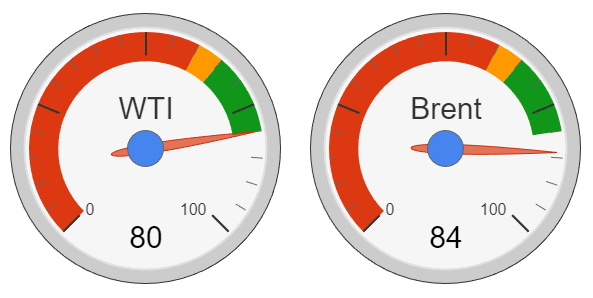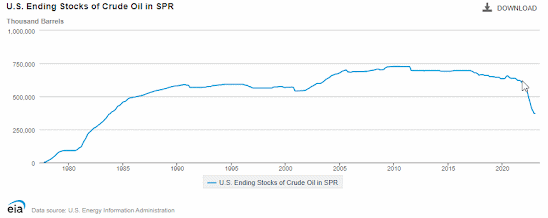 |
| Oil price - April 6 |
The price of crude oil, despite going up by almost 6% on Monday morning, thanks to the abrupt production cuts announced by the OPEC+, lost it momentum again as the days wore on.
As of 11:00 GMT, the prices of WTI and Brent were at $79.48 and $84.56 respectively.
The OPEC+ announced on Sunday that they were going to cut down on production as a 'precautionary measure'; it coincided with the Chinese factory data, released 24 hours earlier, that showed the manufacturing activities took a dive in March for inexplicable reasons.
Up until a few hours before the abrupt announcement, the OPEC+ had been maintaining the polar opposite: there would not be any production cuts.
The move, as it turned out after a few days, did not excite the markets; nor did it push the prices up to unsustainable levels, estimated by some analysts as a hike by at least $10.
On the contrary, as the initial puff died down, the prices clearly started showing the signs of creeping into static territory.
The move, on the other hand, has resulted in unintended consequences: for instance, there are reports that crude oil stocks are growing in the major Middle Eastern exporting countries, despite the West turning their back on Russian oil imports; in this context, the data on the Chinese factory activities for March may have come as a form of shock, for the oil producers in the Middle East in particular and those beyond the region, including Russia, in general.
In addition, the global economic outlook seems to be far from in complete recovery mode; feeble economic activity inevitably leads to cautious optimism and low consumption of oil and related products in south Asia and south Asia, for instance, just reflects the growing concerns in the regions.
The Biden administration that just branded the move by the OPEC+ as 'not advisable', may have breathed a sigh of relief at the prospect of static prices despite the production cuts.
Since the impact on the US consumers due to high energy prices is already well-known, it could have been a hammer blow for the administration if the prices went up, following the immutable demand-supply paradigm, especially when the political opponents pick on them over 'mishandling' the energy crisis.
In order to keep the oil prices at the current levels, the US has been releasing stocks from its own SPR - Strategic Petroleum Reserve - for months, getting some feeble backing from its allies. Inevitably, it has fallen to record lows, as a result; it is estimated to be at its lowest since 1983.
In short, the US cannot keep releasing the oil from its SPR for very long, as the latter is meant to be used only in exceptional circumstances, such as local or international oil disruptions due to wars and critical climate developments such as hurricanes and earthquakes - not for stabilizing the market prices.
As you can see from the above graph, the decline in SPR has accelerated, while the replenishing the stocks at current prices is going to be a very difficult task; the US Energy Secretary has already admitted that it was the case.
The rapidly evolving developments in the energy sectors come at a time , when the so-called de-dollarization moves gather momentum in the Middle East - and elsewhere, incessantly promoted by both China and Russia; it is highly unlikely that the US can use strong-arm tactics to rein in the Middle Eastern suppliers anymore - at present.
The recent Freudian slip by Marco Rubio, the influential Republican Senator, on the 'decline of US dollar hegemony' reflects the way the new developments reverberate in the corridors of power in the US.
Much to its horror, events do take place, literally, on its doorstep: Brazil and China, for instance, agreed to conducting their massive trade and financial transactions directly, exchanging Chinese yuan for Brazilian real and vice versa, instead of using the US dollar for financial settlements for their trade, after putting months of speculation to rest.
The US dollar, however, is not going to lose its importance when it comes to international trading anytime soon and wishing otherwise is going to be in the hypothetical realm for the foreseeable future; yet, there is no room for complacency - as far as the US is concerned.
As for the crude oil markets, the US failed to force the Middle Eastern suppliers to produce more oil for the markets last year, despite repeated attempts to do so; a hastily-arranged trip by President Biden to Saudi Arabia did not cut any ice either.
The widely-reported frosty relationship between the Saudi Crown Prince and President Biden, meanwhile, does not help mending the ties between the two old allies in the very near future.
By removing the Patriotic missile batteries from Saudi Arabia last year, when it was constantly under attack from Houthi drones and missiles, the Saudis were left in a panicky lurch, forcing them to borrow them from Greece for their own protection.
The speed at which Saudi Arabia and Iran, its regional foe, got into the reconciliation mode with the blessings of China, in this context, is perfectly understandable, despite the two regional powers being at the loggerheads for years.
The Iranian factor may have been something that the US cannot politically digest easily in light of Iran's growing influence in the region militarily; a top Iranian general recently boasted that due to its military power, the US aircraft carriers were stationed more than a thousand miles away from the Persian Gulf region!
The sudden visit by Bill Burns, the director of the CIA, to Saudi Arabia in order to highlight the significance of cooperation of intelligence sharing, shows how seriously the US takes the recent developments on the political front, although it is a bit too late for a realistic reversal.
In another significant development in the Middle East, meanwhile, Iraqi federal government and the Kurdish regional government came to an agreement over the distribution of the commodity - and its revenue - in a mutually acceptable way.
Since Iraq is the second largest producer of crude oil, the move will make sure the flow of crude oil to the markets without serious disruptions from the region, where the presence of volatility is as certain as the desert heat.
In addition, the growing closeness between Iran and Saudi Arabia - with China being the strong link - may help the former to find a way for its oil to the markets in due course too, despite the existing sanctions. There are reasons to believe that it is inevitable.
Being in an alliance, vehemently opposed to the war against Ukraine, for instance, failed to stop Japan from buying oil from Russia. Neither did Europe in getting Russian oil via Indian refineries, according to the Indian media.
All in all, there is no sign of a supply crunch in the crude oil markets at present. It is not bleak in the near future either. The stubborn reluctance of oil prices to heading up on price charts, despite significant production cuts, just reflects that simple reality.
HA








